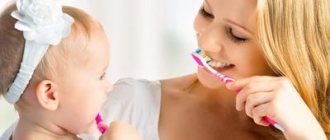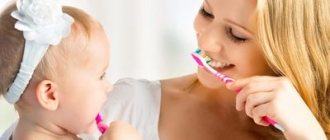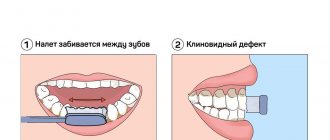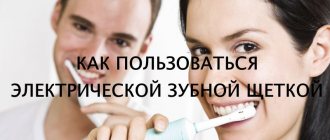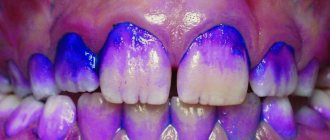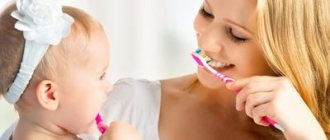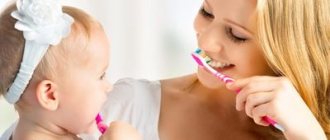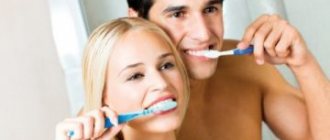Why brush your teeth?
You need to learn how to care for your mouth from early childhood. Of course, children 8–9 months old (the time the first tooth erupts) are not able to do this on their own. Parents should show their concern here.
Plaque on the surface of the enamel is an accumulation of large amounts of tiny food debris. If oral care is not taken on time, plaque increases. Combining with saliva, it mineralizes and becomes a stone that cannot be removed only with a brush. Important: the stone causes caries, periodontitis and other diseases. Caries is a trigger that essentially causes a chain reaction.
Caries and periodontitis
The structure of enamel is naturally porous and rough. Plaque on the surface fills the pores, causing inflammation. This is caries. If no measures are taken and prevention is not carried out, the disease spreads deeper. Over time, the inflammatory process spreads to the gums and roots.
Periodontium is the tissue surrounding the root of the tooth. It fixes it in the bone structure of the jaw. Inflammation in this area leads to the formation of a cyst.
Periodontitis
Destruction of the supporting apparatus of the tooth. At the same time, the gum gradually moves back and a pocket appears. This is where food debris accumulates. It is impossible to remove them yourself. Against this background, the gums swell, begin to bleed, and become sensitive during chewing. Purulent formations may appear in the pocket. Untimely treatment leads to loosening, displacement, and loss of teeth.
Important! Periodontitis is the second most common disease after caries. According to WHO, this pathology is diagnosed in 75% of children and 93% of adults.
Periodontal disease
According to statistics, out of 10 patients, periodontal disease is observed in 6 people. The disease is characterized by impaired blood supply to tissues. This leads to their degeneration and exposure of the neck of the tooth. The gums gradually rise above each other. At the same time, they do not turn red, do not swell, do not bleed, but simply slowly collapse.
Usually the disease affects both jaws at once.
Tooth loss
It needs to be prevented from early childhood. Parents do not always think about the consequences of premature tooth loss in their child. The thinking of some fathers and mothers is as follows: why treat caries of children’s teeth, because they are baby teeth and will soon fall out. This is a big misconception. By affecting baby teeth, caries leads to their premature loss.
Nature intended that the permanent tooth should replace the milk tooth, pushing it out. This order is a normal process. With premature loss, physiology is disrupted, which leads to improper eruption, crooked teeth and changes in bite. Such transformations entail many problems - impaired diction, deformation of facial features, gastrointestinal diseases. Adults experience the same problems when their teeth fall out.
Gastrointestinal diseases
Incorrect bite and lack of proper number of teeth affect the process of grinding food. Insufficiently chewed food ends up in the stomach, which finds it difficult to digest such food. As a result, gastric juice, which contains hydrochloric acid, is released abundantly. A large amount of it irritates the walls of the stomach. Over time, they become inflamed and gastritis develops. In case of untimely treatment, the pattern of disease development is probably known to everyone: gastritis - ulcer - oncology. And it is not a fact that the inflammatory process will not reach the duodenum or intestines.
Chronic pathologies
It would seem, what is a raid? A small buildup on the enamel surface that can be removed with a brush. But many pathogenic bacteria live in this area. If you do not clean the oral cavity, bacteria can migrate through the bloodstream (especially if the integrity of the gum tissue is damaged), move to the tonsils, and into the sinus area. This way the infection can reach any organ.
Think about the numbers! Out of 10 children with early caries, 9 suffer from chronic diseases of the respiratory and ENT organs! According to statistics, caries in childhood causes the development of a chronic form of sinusitis and tonsillitis.
A migrating infection can cause meningitis and provoke encephalitis. Diseases are difficult to treat, their consequences are terrible - dementia, disability.
In medical practice, there are known cases of death from sepsis. The cause is a bacterial infection that first caused tooth decay and then entered the bloodstream and caused sepsis. This advanced disease and its untimely treatment leads to death.
Psychological problems
In childhood, malocclusion becomes the result of crowded teeth, changes in facial features, and impaired diction. Often children feel awkward and begin to develop complexes. In the future, insecure people, already adults, cannot arrange their personal lives. In most cases, the lack of a smile is due to embarrassment and reluctance to talk again.
Psychologists say that in 15% of cases, alcoholism, drug addiction and teenage suicide are associated with complexes about appearance. 10% of them relate specifically to impaired diction and a deformed face due to malocclusion.a
So, caries caused by plaque can cause a lot of negative consequences. This can be avoided by maintaining oral hygiene and paying due attention to your health.
What happens during dental hygiene?
First, the hygienist looks at the size of the stones.
If there are very large ones, then we break them up with ultrasound. Next, we work with the plaque manually using rotating brushes, rubber bands and paste. If you need to get under the gum, there are curette hooks that can be used to clean difficult areas and smooth the surface of the roots so that rotting food does not linger there. Then each gap between the teeth is treated with floss and fine sandpaper. The teeth are then polished. The next stage is strengthening: a disposable mouthguard with a remineralizing solution is placed on the teeth. It then discusses how best to brush your teeth in the future. Then there are two approaches: “industrial” and “archaeological”. If you see sandblasting on soda, then in front of you is a hygienist who wants to do it quickly and powerfully. However, due to the design features of this equipment, it is very difficult to ensure a balance of efficiency and safety, so we consider this approach not the best from the point of view of its relationship to the tissues of the oral cavity (the rough surface of the tooth after a large abrasive gives greater adhesion to sticky food, gum damage is not uncommon). Manufacturing companies are trying to solve this problem, but for now our choice is mechanical contact cleaning.
During cleaning, various chemical agents and “soft” abrasives can be used. If there is inflammation of the gums (which is often associated with “blockages” of stones), then treatment with special antiseptics and agents may be necessary to relieve inflammation. In this case, the appointment is often divided into two: first, the stones above the gum line are removed, then five to seven days pass until the inflammation caused by them subsides, and then the stones below can be worked relatively safely. If you do everything in one go, it won’t be very beautiful: there will be blood in all directions. It’s not that we feel sorry for doing this, it’s just that it prevents us from properly assessing the results of the work inside this bloody mess. That's why we love it when it's clean, the patient doesn't break out and doesn't panic. Gingivitis starting from the middle stage = two doses a week apart.
The procedure itself is painless, but sometimes patients feel ticklish. Sometimes grinding an instrument against your teeth causes unpleasant emotions. There is no problem doing everything under local anesthesia: this is exactly the case when you don’t need to be afraid to ask for it.
Hygiene is done before any more or less serious intervention, since it allows for correct diagnosis later and correctly taking into account the shape of the teeth. Well, the fewer dangerous bacteria there are during invasive procedures near the field, the better.
How often should you brush your teeth?
Dentists recommend caring for your oral cavity 2 times a day (morning and evening). But the hygiene procedure does not end there. To prevent the development of caries, it is necessary to rinse your mouth after every meal. It doesn’t matter whether a person ate an apple, cracked seeds, or had a full lunch.
Intensive rinsing removes harmful bacteria and stuck food pieces. It is, of course, advisable to use special foams or rinses. You can make a solution of salt and soda (1 tsp per 0.5 liter of water). But if this is not possible, then at least use a floss and rinse your mouth with water.
Professional oral hygiene in children
Professional hygiene is usually understood as a set of procedures, the purpose of which is to improve the health of the tissues and organs of the oral cavity and prevent the occurrence of dental ailments. This includes removing soft and hard plaque from teeth, closing fissures, that is, dental dimples, making them less vulnerable, as well as covering the dental surface with a special varnish. The dentist's office is not as treacherous as it looks at first glance. In addition to the preventive procedure, the doctor can conduct an oral hygiene lesson, select a toothpaste and brush for the child based on the individual characteristics of the oral cavity structure, and also give useful and competent care tips.
Finally, I would like to once again draw attention to the fact that caring for a child’s teeth requires special attention due to the subsequent formation of “lifelong” teeth. After all, as healthy as baby teeth are, the molars will be as strong!
How to choose a toothbrush
Not only is the correct cleaning technique important, but also the brush. When choosing a product, you need to navigate their diversity:
- Very soft brushes designed for children. This type is chosen for children over 5 years old, as well as people diagnosed with periodontitis. It is recommended that children under 2 years old brush their teeth with special silicone fingertips.
- Medium bristles hardness. Recommended for teenagers over 12 years old.
- Hard brushes. Can only be used after consulting a doctor. Excessive hardness causes enamel destruction. Recommended for coffee lovers, smokers, and people with increased stone formation. But such brushes can only be used by those who have strong enamel and a healthy oral cavity.
- Very hard brush. We are talking about brushes used in cases where bridges and braces are installed.
- Electric brushes. According to dentists, they are best for removing soft deposits. In addition, there is no need to make additional movements during cleaning. It is enough to slowly move the device over the surface of the teeth, and the electric brush will do the rest itself. But if the gum tissue is weak, then such a procedure can cause injury.
- Ultrasonic brushes. Does not damage gums. Approved for use for diseases of the oral cavity, installed braces or implants. Ultrasound cleans exposed surfaces and removes bacteria at a depth of 5 mm under the gums.
- Working head size. Preference should be given to products with small working heads. In this way, soft tissue injury can be prevented.
Pay attention to the hardness level markings. Responsible manufacturers always indicate it on the packaging:
- sensitive – very soft brushes;
- soft – soft;
- medium – brushes with medium hardness;
- hard – very hard;
- extra-hard – special brushes that remove large amounts of plaque and are intended for people with installed restoration structures.
An important rule: you need to change the brush every 3 months.
Is it possible to independently assess areas of biological damage?
Yes, you can. To do this, you need to buy either Curaprox, Dynal tablets, or Curaprox, PresiDENT liquid at your nearest pharmacy. The tablets are chewed to a cheerful foam and spat out. Considering that you need to carefully and thoughtfully read the instructions to the end, it is better to buy a liquid; it is applied with a special swab or cotton swab. It will be more reliable. But if you have not had hygiene for the last two to three months, then it is better to do it on Friday evening. In fact, it washes off almost immediately, but there is a chance that particularly severe lesions will be stained for about 50 hours. This happens quite rarely and with poor hygiene, but it is a matter of chance.
Choosing a toothpaste
Almost all pastes are therapeutic and prophylactic. Serve for mechanical cleansing and help prevent caries, periodontitis, and periodontal disease. To do this, the composition includes various components that should be taken into account when choosing a care product:
- Fluorides and calcium. Included in the composition for the prevention of caries and restoration of enamel structure.
- Medicinal plants, essential oils, antiseptic substances (chlorhexidine, triclosan). Eliminate bleeding, swelling of the gums, remove plaque.
- Potassium, strontium, aminofluoride, hydroxyapatite. Reduce tissue sensitivity and relieve pain.
- Enzymes (papain) and antimicrobial substances (lysozyme, lactoferrin, lactoperoxidase). Added to whitening pastes to increase the effectiveness of plaque removal.
- Vitamin complex (A, E, C, B, carotoline). Improves metabolic processes, accelerates the healing of the mucous membrane.
You need to choose a paste depending on your existing dental problems. Don't get carried away with fluoride-containing toothpastes. If there is an excess of fluoride, fluorosis can develop. Therefore, fluoride-containing toothpastes are used no more than once a day.
Step-by-step instruction
Cleansing takes 3 minutes! Particular attention should be paid to hard-to-reach areas: gum line, interdental spaces.
Cleaning scheme:
- Wet the brush with warm water.
- Apply the paste in a thin strip to the brush.
- Start cleansing from the upper jaw. First, treat the outer molars and chewing teeth behind the cheeks.
- The direction of movement is from left to right. If you are left-handed, it is better to start on the right.
- The basic rule of the technique is to place the brush parallel to the gums.
- Do not press too hard on the brush.
- Movements are circular, brush each area for 10 seconds. During this time, make 10 movements with the brush.
- Then start brushing from the gums to the bottom edges.
- Next, treat the inner surfaces in the same way.
- Clean your tongue and inner cheeks.
- Rinse your mouth, changing the water 3 times.
Don’t forget to wash your brush and treat it with an antiseptic after each procedure.
How to teach your child to brush his hair regularly?
The next thing you need to teach your child is to comb his hair. Give him a comb. And tell him that you need to use it every time before going outside.
Explain to your child how to use the comb:
- If he wears his hair up, then his head needs to be combed accordingly. You need to start combing your hair on the left. Gradually moving to the right side of the hairstyle. So that every part of the hair is combed.
- If a child wears his hair down, then it needs to be combed accordingly. So that no part of the hair sticks out.
Toothpicks and chewing gum
Dentists do not recommend using toothpicks at all. The wood from which they are made flakes when cleaned. The separated particles can remain between the teeth and, over time, begin to rot and cause inflammation. And also, while using a toothpick, you can injure your gums without even noticing it. Alternatively, use thread.
It is a mistaken belief that chewing gum will help get rid of plaque and stuck pieces of food. Yes, undoubtedly, some parts of the remaining food will stick to the gum. But during the chewing process, when the gums press against each other, these same particles can get stuck in the interdental space.
In addition, recently placed fillings that have not withstood prolonged exposure “like” to stick to chewing gum.
Chewing gum does not strengthen the gums; this happens in the process of uniform chewing, and not when squeezing the jaws in one place. Chewing gum is usually one-sided and can lead to muscle atrophy on the opposite side because it will not receive the stress it needs.
Another disadvantage is that constant chewing will lead to overload of the periodontium. Against this background, periodontitis and gingivitis can develop.
Chewing gum contains dyes and sweeteners. Do not forget that dye E131 (contained, for example, in Stimorol chewing gum) causes the formation of cancer cells, E171 – liver and kidney diseases.
To remove food debris after eating, it is better to rinse your mouth with water 2-3 times or use a mouthwash or foam.
Basic preventive measures
Proper nutrition:
- Limiting easily digestible carbohydrates contained in confectionery products.
- Do not eat sweets at night.
- Do not eat sweets between main meals.
- If paragraphs 2 and 3 have been violated, you must thoroughly rinse your mouth or brush your teeth.
- Ensuring sufficient chewing load (introducing vegetables into the diet).
- For normal teeth growth, you need dairy products, fish, which contain calcium and phosphorus, as well as vegetables and fruits rich in vitamins.
How to properly brush teeth with braces
With braces installed, teeth must be brushed 3 times a day. Regardless of whether you have removable braces or not, cleaning should first be done in the standard way using a brush and paste.
A prerequisite for braces and veneers is the use of an irrigator. This device uses a thin stream of liquid under high pressure to efficiently clean the enamel, gum pockets and the space between the teeth from fresh and old plaque.
How to properly brush your teeth with an electric brush?
The electric brush can make up to 25 thousand rotations per minute. Therefore, the cleansing procedure takes less time.
There are more powerful brushes, for example, from. They make up to 45 thousand rotations per minute.
The usage scheme is, in principle, standard. You don't need to strain or make any movements. She works on her own. The brush should be held parallel to the teeth, without pressing, and moved along the surface.
The procedure time is 1.5–2 minutes.
Dr. Zubastik recommends
After each procedure, rinse the brush. Do not store children's and adult teeth-cleaning devices in the same place - the infection can easily spread to neighboring hygiene products.
Interesting! Ancient people ate food given by nature itself, receiving a large amount of vitamins and a massage effect for the gums. They lived to old age, keeping all their teeth in excellent condition. Our ancestors ate rough, solid food and fruits without using a knife. According to anthropological researchers, ancient man did not know caries. The lack of teeth could only be a consequence of surviving and fighting the beast.
Tags: braces, toothbrush, toothpicks, teeth cleaning
About the author: Dr. Zubastik
Typically, a toothache begins to subside on the way to the clinic and finally goes away after 10 minutes of sitting in line to see the dentist.
- Related Posts
- 5 home care products for braces
- Why should you brush your teeth morning and evening?
- Can tartar fall off on its own?
« Previous entry
Does the irrigator work?
A toothbrush removes about 70% of biofoci. The rest are located where mechanically cannot be reached, for example, at contact points. So yes, the irrigator complements regular teeth cleaning very well. If you can, use it every time. But just don’t take stationary ones that require connection to a household power supply. Practice shows that my patients do not use these because of the difficulty of turning them on in the bathroom. It’s better to use mobile phones with batteries, they are much simpler and always at hand near the sink.



